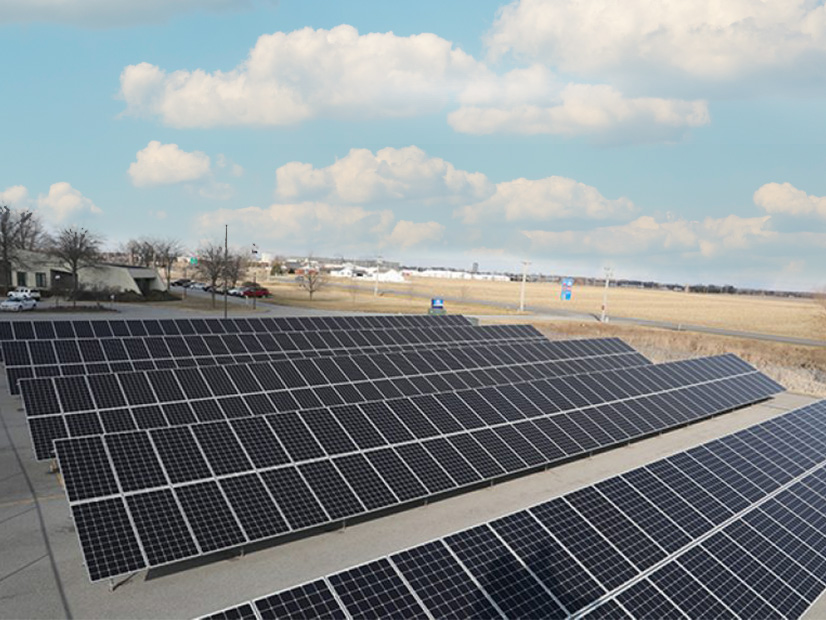The Indiana Utility Regulatory Commission last week approved a rule change to dramatically cut the net metering credits earned by rooftop solar owners in southwest Indiana.
The commission granted CenterPoint Energy subsidiary Vectren South a new net metering rate of about 3 cents/kWh, slashing the current rate of about 14 cents/kWh for residential and 9 cents/kWh for commercial customers (45378). CenterPoint must file a new rate schedule with the commission before the change can be implemented.
The decision in CenterPoint’s favor could set the tone for Indiana’s entire rooftop solar industry. Four other investor-owned utilities recently filed proposals to reduce reimbursements for distributed solar generation. Only Northern Indiana Public Service Co. has committed to keeping retail rate net metering in place for the time being.
In issuing the decision, the IURC called itself a “a creature of statute” and said the new rate doesn’t violate any laws. It also contended that it does not have the authority to devise a new rate, as some solar developers requested.
The new rate is based on average real-time MISO locational marginal prices of about $25/MWh at Vectren South’s load node in 2019, multiplied by 1.25.
CenterPoint counsel Matthew Rice said the new rate “appropriately provides compensation to the solar customer based on the rate the utility could have purchased the same energy at wholesale, plus a 25% adder.”
CenterPoint’s customers with distributed solar assets will also be compensated at the lower rate using instantaneous billing instead of monthly netting.
Rice said monthly netting “creates a false price signal for customers.”
He said customers in the net metering program currently enjoy an incentive “in excess of the value provided to the system.”
In its request for lower credits, CenterPoint predicted that Vectren South would exhaust its available net metering capacity by the end of 2020. As of Aug. 31, 2020, the utility had about 2,152 kW of capacity available in its program, with 3,236 kW in its queue either approved or awaiting approval. It said it had already freed up capacity by making an underused category reserved for biomass generation available to rooftop solar owners.
Vectren South has a net metering cap of 1.5% of its retail peak load, or about 16.5 MW. If that limit is exhausted before 2022, customers with solar installations will earn the wholesale plus 25% adder rate. The new rate is also set to apply to all customers with systems installed after 2022.
Owners, Installers Protest
The Indiana Office of Utility Consumer Counselor fielded numerous comments that the new tariff will make customer-owned solar generation out of reach. Clean energy proponents Citizens Action Coalition of Indiana, Environmental Law and Policy Center, Vote Solar and Solar United Neighbors also opposed the ruling.
Such a low compensation rate will have a chilling effect on the young distributed solar industry, solar developers said.
Solarize Indiana’s Jay Picking said the rate change will “practically destroy the residential solar market” in Vectren South’s service territory.
Johnson Melloh Solutions Vice President Kurt Schneider, whose company provides solar projects and energy efficiency solutions, said the rate decrease “will undermine the future of JMS’ Indiana solar business.” He said the lower the credit customers receive, the less likely they are to hire solar installers.
Schneider said CenterPoint’s “instantaneous netting methodology will drastically reduce or dry up JMS’ Indiana solar business in Vectren South’s service area,” and that the plan “will more than triple the customer payback [period] from seven to 10 years to about 25 years.”
Schneider asked the commission to minimize CenterPoint’s “brutal treatment” of distributed solar.
Rice countered that instantaneous netting produces rates “that better approximate the cost and reality of serving [distributed] customers because [the] distribution and transmission system must not only meet peak requirements but must also absorb any additional input from [distributed generation] resources without creating failures for its other customers.”
Morton Solar owner Brad Morton said large business customers typically seek a payback period of five to six years, while residential customers look for seven to 10 years. He agreed the new rate would likely draw out the investment recovery period to 25 years or more.
The reduced rate will make customers “extremely reluctant or unwilling to invest in solar, which will be devastating to Indiana’s fledgling solar industry and result in job losses and probable market contraction to an industry just beginning to blossom,” Morton said.
Former adviser to the Office of Consumer Counselor Edward Rutter, now with the Indiana Distributed Energy Alliance, said the longer recovery periods will likely outlast the lifespan of the panels themselves.
EQ Research Principal Energy Policy Analyst Ben Inskeep tweeted that the decision is “incredibly shortsighted” and would “effectively kill rooftop solar for the foreseeable future for all CenterPoint customers.”
Rooftop solar user and advocate Michael Mullett, a customer of Duke Energy Indiana, testified that a 3 cent/kWh rate is “arbitrary and confiscatory.”
The commission, however, ruled that distributed generation owners’ shorter payback periods generate extra costs for the utility’s other ratepayers.
“We find the evidence demonstrates that, ultimately, [distributed generation] customers’ faster payback periods translate to the utility’s other customers paying costs associated with the excess electricity DG customers put on Vectren South’s system — whether needed or not,” the commission said. “Accordingly, we cannot conclude it is just and reasonable for [CenterPoint’s] other customers to subsidize the payback periods of [distributed generation] customers by the continuation of monthly netting as opposed to instantaneous netting.”
The commission also said solar panel owners can partly receive a return on their investment simply by generating their own power and purchasing less from the utility.




